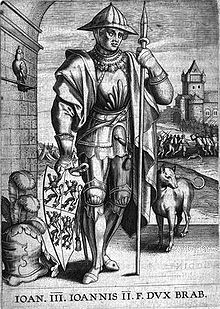John III, Duke of Brabant
| John III | |
|---|---|
|
Duke of Brabant Duke of Lothier Duke of Limburg |
|
 |
|
| Spouse(s) | Marie d'Évreux |
| Issue | |
|
Titles and styles
The Duke of Brabant, Lothier and Limburg
|
|
| Noble family | House of Reginar |
| Father | John II, Duke of Brabant |
| Mother | Margaret, Princess of England |
| Born | 1300 |
| Died | 5 December 1355 Brussels |
John III (Dutch: Jan; 1300 – 5 December 1355) was Duke of Brabant, Lothier, and Limburg (1312–1355). He was the son of John II, Duke of Brabant, and his wife Margaret, daughter of King Edward I of England and Eleanor of Castile.
In 1311, as his father's gesture of rapprochement with France, John married Marie d'Évreux (1303–1335), the daughter of count Louis d'Évreux and Margaret of Artois. They had six children:
The early fourteenth century, an economic boom time for Brabant, marks the rise of the Duchy's towns, which depended on English wool for their essential cloth industry. During John's minority, the major towns of Brabant had the authority to appoint councillors to direct a regency, under terms of the Charter of Kortenberg granted by his father in the year of his death (1312). By 1356 his daughter and son-in-law were forced to accept the famous Joyous Entry as a condition for their recognition, so powerful had the States of Brabant become.
The marital alignment with France was tested and failed as early as 1316, when Louis X requested Brabant to cease trade with Flanders and to participate in a French attack; the councillors representing the towns found this impossible, and in reprisal Louis prohibited all French trade with Brabant in February 1316, in violation of a treaty of friendship he had signed with Brabant in the previous October.
After his initial period of maintaining independent neutrality from both France and England failed, neighboring sovereigns in the Low Countries, stimulated as a matter of policy by Philip VI of France, became John's enemies; among the adversaries of John were the Count of Flanders, the prince-bishop of Liège, and counts of Holland and Guelders. In 1332, a crisis with the king of France arose over John's hospitality to Robert, count of Flanders, during his journey to eventual asylum at the English court. In response to French pressure John reminded Philip that he did not hold Brabant from him but from God alone. A brief campaign of a coalition of Philip's friends came to a truce, followed by a pact at Compiègne by which John received a fief from Philip worth 2000 livres and declared himself a vassal of France. His oldest son, Jean, was betrothed to Philip's daughter Marie, and it was agreed that the Brabançon heir would complete his education at the French court in Paris and that Robert of Artois would be expelled from Brabant.
...
Wikipedia
